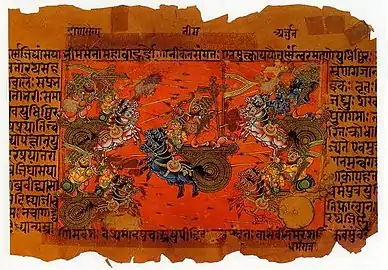Bhishma
In the Mahabharata, Bhishma (Sanskrit: भीष्म, IAST: Bhīṣma) also known as Bhishma Pitamaha and Gangaputra Bhishma[1] was well known for his pledge of celibacy. Originally named as 'Devavrata', he was the eighth son of the Kuru King Shantanu and the river goddess Ganga.[2] Bhishma was blessed with a boon from his father that he could choose the time of his death or he may remain immortal till he desires.[3] He was related to both the Pandavas and the Kauravas through his half-brother, Vichitravirya (Son of Satyavati).[4] He was one of the greatest archers and warriors of his time and was trained by Lord Vishnuś sixth avatar Parshurama . He also handed down the Vishnu Sahasranama to Yudhishtira[5] when he was on his bed of arrows after the battle of Kurukshetra.
| Bhishma | |
|---|---|
| Mahabharata character | |
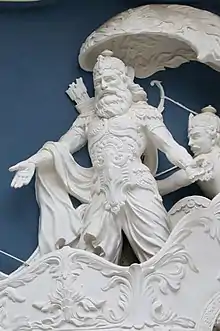 Statue of Bhishma standing on a chariot. | |
| In-universe information | |
| Aliases | Devavrata, Gauranga, Gangaputra, Pitaamaha |
| Gender | Male |
| Weapon | Bow & arrows, sword, mace |
| Family |
|
| Home | Hastinapur |
Etymology
In Sanskrit, the word Bhishma (भीष्म) means 'one who undertakes a fierce vow (Bhishma pratigya) and fulfils it.'[6]
His other names are as follows –
- Devavrata (देवव्रत) - one who is devoted to Gods. It was also Bhishma's original name.
- Gangaputra (गंगापुत्र) – son of Ganga
- Gangadatta (गंगादत्त) - given/granted by Ganga.
- Shantanava (शान्तनव) – descendant (son) of Shantanu. Only he has the name as he took the oath of celibacy for the sake of his father.
- Gauranga (गौरांग) – the one with fair body
- Shvetaveera (श्वेतवीर) – a white warrior or the one who is heroic white and has all weapons in white color
- Ashta Vasu (अष्ट वसु) – elemental gods (in previous life)
- Bharatavanshi (भरतवंशी) - descendant of Bharata
- Pitamaha (पितामह)- Grandfather (also known as Bhishma Pitamaha; called by Pandavas and Kauravas)
Birth and Early Life
King Shantanu saw a beautiful woman on the banks of the river Ganges (Ganga) and asked her to marry him. She agreed but with one condition: that Shantanu would not question her actions. Shantanu accepted her condition and made a vow never to ask her the reason for her actions. They married and she later gave birth to a son but drowned the child very soon after his birth. Shantanu could not ask her the reason, because of his promise, she would leave him. One by one, seven sons were born to them and were all drowned by Ganga.
.jpg.webp)
When Ganga was about to drown the eighth son, Shantanu, devastated, could not restrain himself and confronted her. Finally, Ganga explained to King Shantanu about Brahma's curse given to Mahabhisha and her. Then, she told him that their eight children were Eight Vasus who were cursed by the renowned sage Vasishtha to be born on earth as mortal humans however when they pacified him, he limited his curse and told them that they would be freed from this curse within a year of their birth as humans. So, she released seven of them from this life by drowning them all. However, the eighth child Bhishma, the amsha of Prabhasa was destined to live a long life and never have a wife or have children. However, the sage also gave a boon to him that he would be virtuous, conversant with all the holy scriptures, and will be an obedient son to his father.
Ganga told Shantanu that she will take him to the heavens to train him properly for the King's throne and status following his birth. With these words, she disappeared along with the child while Shantanu was struck with grief thinking about spending the rest of his life without her.[7]
The legend behind Bhishma's birth is as follows – once the eight Vasus ("Ashtavasus") visited Vashishta's ashram accompanied by their wives. One of the wives took a fancy to Kamadhenu, Vashishta's wish-bearing cow, and asked her husband Prabhasa to steal it from Vashishta. Prabhasa then stole the cow with the help of the others who were all consequently cursed by Vashishta to incarnate in the world of humans. Upon the Vasus appealing to Vashishta's mercy, the seven Vasus who had assisted in stealing Kamadhenu had their curse mitigated such that their avatars would be liberated from their human birth as soon as they were born; however, Prabhasa being the protagonist of the theft was cursed to endure a longer life on the earth. The curse, however, is softened to the extent that his avatar would be one of the most illustrious men of his time. It was this Prabhasa also called Vasu Dyaus whose avatar was Bhishma.
_to_his_father%252C_Santanu..jpg.webp)
After Devavrata was born, his mother Ganga took him to different realms, where he was brought up and trained by many eminent sages (Mahabharata Shanti Parva, section 38).[8]
- Brihaspati: The son of Angiras and the preceptor of the Devas taught Devavrata the duties of kings (Dandaneeti), or political science and other Shastras.
- Shukracharya: The son of Bhrigu and the preceptor of the Asuras also taught Devavrata in political science and other branches of knowledge.
- Vashishtha, the Brahmarshi and Chyavana, the son of Bhrigu taught the Vedas and Vedangas to Devavrata.
- Sanatkumara: The eldest son of Lord Brahma taught Devavrata the mental and spiritual sciences.
- Markandeya: The immortal son of Mrikandu of Bhrigu's race who acquired everlasting youth from Lord Shiva taught Devavrata in the duties of the Yatis.
- Parashurama: The son of Jamadagni of Bhrigu's race and the pupil of Shiva. Parashurama trained Bhishma in warfare.
- Indra: The king of the Devas. He bestowed celestial weapons on Bhishma.
After learning from various teachers, Devavrata became a capable ruler. Ganga handed her son to Shantanu as per her promise and the young Devavrata was known as Gangadatta as he was handed over by Ganga.[9]
Bhishma's Oath
Originally named Devavrata, he became known as Bhishma after he took the bhishamna pratigya ('fierce oath') — the vow of lifelong Brahmacharya (celibacy) and of service to whosoever sat on the throne of his father.[6]
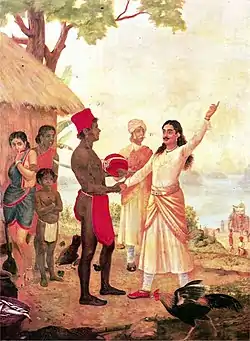
Having joined his father's court, Bhishma was easily confirmed as the heir apparent. Having undergone a successful military campaign, and being the child of a goddess himself, he was loved by all in the city. Shantanu was proud of his son and content that the future was secure.
However, the king had slowly been falling in love with a fisherwoman, Satyavati, who operated the boats crossing the Yamuna, one of Hastinapur's rivers. When Shantanu approached for her hand in marriage, Satyavati's father, Dasraj, refused to give his daughter's hand to Shantanu unless Shantanu would proclaim the children born to her as his heirs. However, doing so would be against the merit-based hereditary rules of Bharat, and Shantanu had already promised the throne to Bhishma. So, Shantanu sorrowfully had to reject the offer. This made Shantanu despondent, and upon discovering the reason for his father's despondency, Devavrata sought out the girl's father and ceded his claim to the throne. At this, Satyavati's father retorted that even if Devavratha gave up his claim to the throne, Devavrata's children would still claim the throne. Devavrata then took the vow of lifelong celibacy, thus sacrificing his 'crown-prince' title and denying himself the pleasures of conjugal love.[10]
His father granted him the boon of Ichcha Mrityu (control over his own death – he could choose the time of his death, making him immortal till his chosen time of death). Criticism of King Shantanu from his subjects as to why he removed Bhishma from the title of the crown prince, as he was so capable, abounded. There was worry about the nobility of Shantanu's unborn children, now promised the throne. Hearing this, Bhishma said it was his decision and his father should not be blamed as Shantanu had never promised anything to Satyavati's father. The prime minister then asked who would be held responsible if the future crown prince isn't capable enough. Bhishma then took another vow that he would always see his father's image in whoever sat on the King's throne, and would thus serve the king faithfully & truthfully.[11]
Amba's hatred
Abduction of the princesses of Kashi
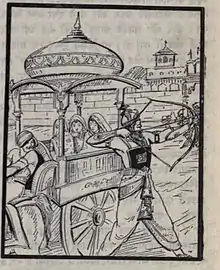
Years later, in the process of finding a bride for his half-brother, the young king Vichitravirya, Bhishma abducted princesses Amba, Ambika and Ambalika of Kashi from the assemblage of suitors at their swaymvara. Salwa, the ruler of Saubala, and Amba (the eldest princess) were in love; Salwa attempted to stop the abduction but was soundly beaten. Upon reaching Hastinapura, Amba confided in Bhishma that she wished to wed Salwa. Bhishma then sent her back to Salwa, who, bitter from his humiliating defeat at Bhishma's hands, turned her down. She then retired to Bhishma for Vichitravirya who refused to accept citing the rules that what once given cannot be taken back. Amba then sorrowfully, repair to an asylum of ascetics out of city. She then explains everything to them. They made her meet with Parasurama. Hearing the words of the princess, Parasurama asked her motive. As per the words of ascetics, she asked him to slay that Bhishma of great vows, who is the root of her calamity.[12]
Fight with Parashuram
Amba sought refuge with Parasurama, who ordered Bhishma to marry Amba, telling Bhishma it was his duty. Bhishma politely refused, saying that he was ready to give up his life at the command of his teacher but not the promise that he had made. Both mocks each other and upon the refusal,Parasurama called him for a fight at Kurukshetra. At the battlegrounds, while Bhishma was on a chariot, Parasurama was on foot. Bhishma requested Parasurama to also take a chariot and armour so that Bhishma would not have an unfair advantage. Parasurama blessed Bhishma with the power of divine vision and asked him to look again. When Bhishma looked at his guru with the divine eyesight, he saw the Earth as Parasurama's chariot, the four Vedas as the horses, the Upanishads as the reins, Vayu (wind) as the Charioteer and the Vedic goddesses Gayatri, Savitri, and Saraswati as his armour. Bhishma got down from the chariot and sought the blessings of Parashurama to protect his dharma, along with permission to battle against his teacher. Pleased, Parashurama blessed him and advised him to protect his vow as Parasurama himself had to fight to uphold his word as given to Amba. They fought for 18 days, each knocking out other at a time, used even the celestial weapons, but each was too powerful to defeat the other. Their battle lasted for 18 days. But on 22nd night, he asked the gods to show him a way to vanquish Parasurama, at night. In his dream, his ancestors came and provided him the knowledge of Praswapa weapon, not known to any persons on earth.[12]
On 23rd day of battle, when battle didn't conclude, Bhishma attempted to use the Prashwapastra against Parashurama. This weapon was not known to Parasurama and would put the afflicted to sleep in the battlefield. Before Bhishma could release it, however, a voice from the sky warned him that "if he uses this weapon it would be a great insult towards his Guru." Pitrs then appeared and obstructed the chariot of Parashurama, forbidding him from fighting any longer. At the behest of the divine sage Narada and the gods, Parashurama ended the conflict and the battle was declared stale mate.(effect of any astra on parashurama is not clear as he is avatara of Lord Vishnu and chiranjivi).
In another version, Parashurama himself stopped the fight after twenty-three days, worried that the further use of powerful weapons may lead to the destruction of the world.
Parashurama narrated the events to Amba and told her to seek Bhishma's protection. However, Amba refused to listen to Parashurama's advice and left angrily declaring that she would achieve her objective by asceticism. Her predicament unchanged, she did severe austerities to please Shiva. She was cursed by Ganga, during her penances, when she didn't listen to her words. Lord Shiva assured her that she would be born as a man named (Shikhandi) in her next birth (and still she would recall her past) and could be instrumental in Bhishma's death, thus satisfying her vow. She then made funeral pyre of woods, on the banks of the Yamuna, setting fire to it herself entered that blazing fire with wrath, uttering-'I do so for Bhishma's destruction!'[13]
Role in the events of Hastinapura
Birth of Vichitravirya's children
After Vichitravirya was crowned as the king of Hastinapura, he died because of a health issue. With no heir to the throne, Satyavati asked Bhishma to marry the widows of Vichitravirya (following the practice of niyoga in its narrower sense, as a levirate marriage)[14] and rule as king. But Bhishma refused the proposal and reminded his vow to his step mother. He suggests that a Brahmin could be hired to father children on the widows, thus preserving the dynasty.[15] Satyavati revealed her secret past and called her first born, Vyasa, to impregnated her daughter in laws.[16][17][18] After Dhritarashtra and Pandu were born, Bhishma trained them to become powerful warriors.[19]
Marriages of Dhritrashtra and Pandu
When Dhritrashtra was ready to get married, Bhishma and Satyavati started to look for an eligible bride. Bhishma then heard about Gandhāri, princess of Gandhara. He arrived Gandhara and asked Subala for his daughter, who was blessed to have hundred sons. Gandhari's brother Shakuni objected his sister's marriage with a blind, but had no choice. Gandhari, in order to feel the same pain as her husband, blind folded herself. The Mahabharata describes that this incident developed Shakuni's hatred towards Bhishma and Hastinapur.[20][21]
Although Dhritrashtra was the eldest, Pandu was made the king of Hastinapur due to Dhritrashtra's blindness. Pandu married Kunti but after his military campaign, Shalya and Bhishma decided to get him married to Madri for political reasons. One day, Pandu killed sage Kidama and got his infamous curse.[22]
Training of Kuru princes
After the death of Pandu, Kunti returned to Hastinapur with her five sons, Pandavas— Yudhishthira, Bhima, Arjuna, Nakula and Sahadeva. Dhritrashtra's sons (Kauravas) were not pleased by the arrival of their cousins. Satyavati, along her daughter in laws, left Hastinapur for penance, leaving Bhishma with the responsibility of the kingdom. One day, the princes were playing with a ball, but it fell into a well. They were unable to take it out, until a Brahmin warrior, Drona, helped them using his impressive skills. Bhishma was impressed with the Brahmin's skills and hired him as the teacher of the princes.[23]
In The Kurukshetra War
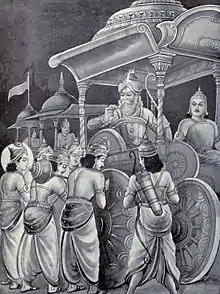
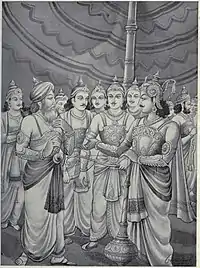
In the great battle at Kurukshetra, Bhishma was the supreme commander of the Kaurava forces for ten days. He fought reluctantly on the side of the Kauravas. Bhishma was one of the most powerful warriors of his time and in history. He acquired his prowess and invincibility from being the son of the sacred Ganga and by being a student of Lord Parashurama. Despite being about five generations old, Bhishma was too powerful to be defeated by any warrior alive at that time. Every day, he slew at least 10,000 soldiers and about a 1,000 rathas. At the beginning of the war, Bhishma vowed not to kill any of the Pandavas, as he loved them, being their grand-uncle. Duryodhana often confronted Bhishma alleging that he was not actually fighting for the Kaurava camp as he wouldn't kill any of the Pandavas. He also did not allow any of the Kauravas to be killed in the war, as he loved all his grand-nephews and wanted a peace negotiation.
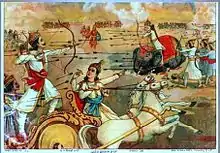
Duryodhana approached Bhishma one night and accused him of not fighting the battle to his full strength because of his affection for the Pandavas. On the next day there was an intense battle between Bhishma and Arjuna. Although Arjuna was very powerful, he was not fighting seriously as his heart was not in it to hurt his beloved grandsire Bhishma. Bhishma fired arrows such that Arjuna and Krishna were both injured. That angered Krishna who took vow of not raising a weapon in the war, lifted a chariot wheel and threatened Bhishma. Arjuna stopped Lord Krishna. Arjuna convinced Krishna to return to the chariot and put down the wheel, promising to fight with all his might and stop Bhishma. Thus Bhishma fulfilled his vow and then Arjuna used stronger weapons, slightly injuring Bhishma. Bhishma and Arjuna's duel was praised by the gods themselves as they watched over it from the sky.
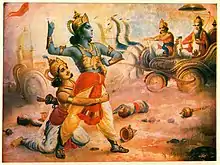
The war was thus locked in a stalemate. As the Pandavas mulled over this situation, Krishna advised them to visit Bhishma himself and request him to suggest a way out of this stalemate. Bhishma loved the Pandavas and knew that he stood as an obstacle in their path to victory and so when they visited Bhishma, he gave them a hint as to how they could defeat him. He told them that if faced by one who had once been of the opposite gender, he would lay down his arms and fight no longer.
Later Krishna told Arjuna how he could bring down Bhishma, through the help of Shikhandi. The Pandavas were not agreeable to such a ploy, as by using such tactics they would not be following the path of Dharma, but Krishna suggested a clever alternative. And thus, on the next day, the tenth day of battle Shikhandi accompanied Arjuna on the latter's chariot and they faced Bhishma who did not fire arrows at Shikhandi. He was then felled in battle by Arjuna, pierced by innumerable arrows. With Sikhandhi in front, Bhishma did not even look at that direction, Arjuna shot arrows at Bhishma, piercing his entire body. Thus, as was preordained (Mahadeva's boon to Amba that she would be the cause of Bhishma's fall) Shikhandi, that is, Amba reincarnated was the cause of Bhishma's fall. As Bhishma fell, his whole body was held above the ground by the shafts of Arjuna's arrows which protruded from his back, and through his arms and legs. Seeing Bhishma lying on such a bed of arrows humbled even the gods who watched from the heavens in reverence. They silently blessed the mighty warrior. When the young princes of both armies gathered around him, inquiring if there was anything they could do, he told them that while his body lay on the bed of arrows above the ground, his head hung unsupported. Hearing this, many of the princes, both Kaurava and the Pandava alike brought him pillows of silk and velvet, but he refused them. He asked Arjuna to give him a pillow fit for a warrior. Arjuna then removed three arrows from his quiver and placed them underneath Bhishma's head, the pointed arrow tips facing upwards. To quench the war veteran's thirst, Arjuna shot an arrow into the earth, and a jet stream of water rose up and into Bhishma's mouth. It is said that Ganga herself rose to quench her son's thirst.[12]
Death
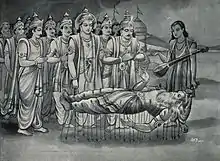
After the war, while on his deathbed (arrow bed), he gave deep and meaningful instructions to Yudhishthira on statesmanship and the duties of a king. Bhishma always gave priority to Dharma. He always walked in the path of Dharma, despite his state because of the vow, he was supposed to forcefully follow the orders of his king Dhritharashtra, which were mostly Adharma, he was totally upset. He was sure he must let dharma win and Pandavas win, but the way he led the war and stayed silent were his sins in a way and he paid for it with the bed of arrows. Finally, Bhishma gave up the fight, focusing his life force and breath, sealing the wounds, and waiting for the auspicious moment to give up his body on the arrow bed. He did wait for about 58 nights for the winter solstice or first day of Uttarayana to give up his body on the arrow bed. Mahabharata states that he attained salvation after his death. He was granted the Maatru Lok (which is considered even above Swarga, the heaven). Magha (month) Shukla Ashtami marks the death anniversary of Bhishma Pitamah(Father), the day being known as Bhishma Ashtami. Hindus observe Ekodishta Śrāddha for him on this day, since many generations, and can only be performed by those whose fathers are not alive. Bhishma Panchaka vrata(fast) is observed in all Vishnu temples, starting from Bhishma Ashtami, for five days till Bhishma Dwadasi. People believe that they will be blessed with a son, having the steadfast qualities of Bhishma if they observe these holy rituals on the river banks.[24] It is also said that those who will perform this fast will live a happy life and attain salvation after their death.
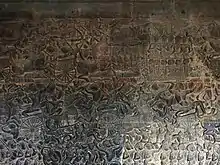
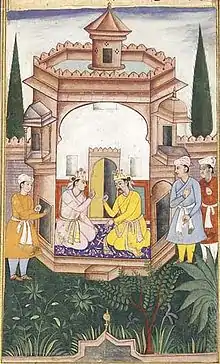
In popular culture
Films and Television
His life has been made into many films in different Indian languages. The first silent film was made in 1922. During the talkie period, the first film was made in Hindi (1937). It was followed by a Bengali film in 1942 directed by Jyotish Bannerjee. Jahar Ganguli played the title role.
- Telugu cinema, two films were made. The first film on Bhishma was made in 1944 directed by Chitrapu Narayana Rao. Jandhyala Gourinatha Sastry played the role of Bhishma. B. A. Subba Rao made a film in 1962 titled Bhishma. The title role was played by N. T. Rama Rao.
- Bhishma's character was played by Mukesh Khanna in the B.R. Chopra's classic television series Mahabharat (1988).
- In Ramanand Sagar's television series Shri Krishna (1993) Sunil Nagar portrayed the character.
- Surendra Pal portrayed the character in Chandraprakash Dwivedi's Ek Aur Mahabharat.
- In the television series Draupadi (2001) Pankaj Dheer played the character.
- In Balaji Telefilms' Kahaani Hamaaray Mahaabhaarat Ki (2008) Ronit Roy played the role.
- In Star Plus' television series Mahabharat (2013) Aarav Chowdhary played the role of Bhishma.
- Amitabh Bachchan has also voiced the character in the animated Mahabharat (2013).
- Naved Aslam in Sony TV's Suryaputra Karn.
- Ambareesh played the role of Bhishma in the 2019 mythological Kannada movie Kurukshetra, which was his last film as well.
Modern references
The tank T-90 Main Battle Tank, one of the world's most advanced MBTs acquired from Russia for the Indian Army is named after Bhishma.[25][26]
See also
- Vishnu Sahasranama - The Thousand names of Lord Vishnu
- Warrior Monk
- Vasu - The Deities of Gods
- Ganga - Mother of Bhishma
- Shantanu - Father of Bhishma
- Satyavati - Step Mother of Bhishma
References
- B. R. Rajam Aiyar (30 September 1996). Rambles in Vedanta. Motilal Banarasi Das Publishers Pvt Ltd. pp. 113–114. ISBN 9788120809123. Retrieved 7 May 2020.
- Manish Verma (2000). Fasts and Festivals of India. Diamond Pocket Books (P) Ltd. pp. 73–. ISBN 978-81-7182-076-4. Retrieved 13 June 2012.
- Mayank Srivastava. "ये हैं महाभारत के 15 मायावी योद्धा, अपनी मायावी शक्तियों से देवताओं तक को कर दिया था परेशान". newstrend.news (in Hindi). Newstrend. Retrieved 7 May 2020.
- "Bhishma". Encyclopedia for Epics of Ancient India. Retrieved 17 April 2012.
- Mahabharatha
- "Mahabharat-Bhishma-Pratigya-story-why-did-Gangas-son-Devavrata-come-to-be-known-as-Bhishma-in-Mahabharata". Jansatta (in Hindi). 16 April 2020. Retrieved 29 August 2020.
- "Mahabharta-the-story-of-the-birth-of-Bhishma-Pitamah-Ganga-and-king-s Shantanu". Dainik Bhaskar (in Hindi). 20 March 2020. Retrieved 29 August 2020.
- "Why Devavrata came to be known as Bhishma?". Zee News. 12 April 2017. Retrieved 29 August 2020.
- Narasimhan, Chakravarthi V. (1999). The Mahābhārata: An English Version Based on Selected Verses. Motilal Banarsidass Publ. ISBN 978-81-208-1673-2.
- Ireland, Royal Asiatic Society of Great Britain and (1879). Journal of the Royal Asiatic Society of Great Britain and Ireland. Cambridge University Press for the Royal Asiatic Society.
- "Devavrata's oath". The Hindu. 7 July 2016. ISSN 0971-751X. Retrieved 29 August 2020.
- Bhanu, Sharada (1997). Myths and Legends from India – Great Women. Chennai: Macmillan India Limited. pp. 30–8. ISBN 0-333-93076-2.
- "Mahabharata Story By Rajaji - Page 5 | Mahabharata Stories, Summary and Characters from Mahabharata". www.mahabharataonline.com. Retrieved 29 August 2020.
- Meyer pp. 165-6
- Ganguli, Kisari Mohan (1883–1896). "SECTION CIV". The Mahabharata: Book 1: Adi Parva. Sacred texts archive.
- Choppra, Kusum (17 June 2017). "Satyavati, the feminist who stood up to patriarchy". DNA India. Retrieved 26 October 2020.
- Ganguli, Kisari Mohan (1883–1896). "SECTION CIII". The Mahabharata: Book 1: Adi Parva. Sacred texts archive.
- Meyer p. 165
- Mani 1975.
- Srivastava, Diwaker Ikshit (11 December 2017). Decoding the Metaphor Mahabharata. One Point Six Technology Pvt Ltd. ISBN 978-93-5201-000-4.
- "The Mahabharata, Book 1: Adi Parva: Sambhava Parva: Section CX". www.sacred-texts.com. Retrieved 1 September 2020.
- Debalina (20 December 2019). Into the Myths: A Realistic Approach Towards Mythology and Epic. Partridge Publishing. ISBN 978-1-5437-0576-8.
- Dalal, Roshen (18 April 2014). Hinduism: An Alphabetical Guide. Penguin UK. ISBN 978-81-8475-277-9.
- "Bhishma Ashtami". Drik Panchang. Retrieved 24 January 2019.
- Robert Jackson (1 March 2007). Tanks and Armored Fighting Vehicles. Parragon Incorporated. pp. 295–. ISBN 978-1-4054-8664-4. Retrieved 24 June 2012.
- S. Muthiah (2008). Madras, Chennai: A 400-year Record of the First City of Modern India. Palaniappa Brothers. pp. 288–. ISBN 978-81-8379-468-8. Retrieved 24 June 2012.
Bibliography
- Mani, Vettam (1975). Puranic Encyclopaedia: a Comprehensive Dictionary with Special Reference to the Epic and Puranic Literature. Motilal Banarsidass Publishers. ISBN 978-0-8426-0822-0.
- Meyer, Johann Jakob (1989) [1971]. Sexual life in ancient India. Motilal Banarsidass Publ. ISBN 81-208-0638-7.
External links
| Wikiquote has quotations related to: Bhishma |
| Wikimedia Commons has media related to Bhishma. |
